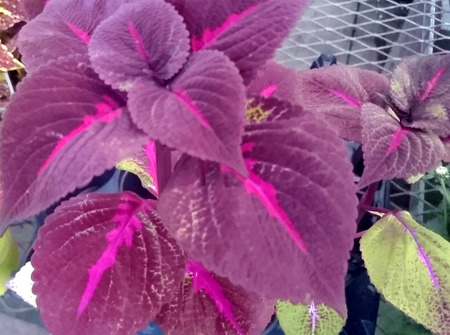Perilla - Perilla frutescens

Common Names: Perilla, beefsteak plant, shiso, wild coleus, wild basil, Chinese basil, Japanese basil, Korean perilla, purple mint, purple perilla, Zi Su, deulkkae, kkaennip, chamkkae, egoma, baizisu, Pérille, basilic japonais, dentidia nankinensis, shiso japonais, silam, Huile de Pérille, mentha perriloides, ebara, Aka-shiso, akajiso, Ao-shiso, soyop, soyeob, Ggaesip, Tía to, Lá Tía to, Perilla frutescens
Latin Name: Perilla frutescens
Origin: Asia, Europe, South America, North America
Short Introduction
Cultivated primarily for its seeds and especially its leaves, Perilla should be sown in early May and harvested from late September to early October. It prefers slightly acidic soils with a pH between 6.5 and 5.0. Seeds are planted in holes about 10 cm deep and lightly covered with soil. Perilla enjoys regular, even light watering. To encourage tall and bushy growth, it is recommended to pinch back the plant every two weeks. Though native to the tropical and subtropical regions of Southeast Asia, Perilla can be grown in temperate climates such as the Czech Republic, requiring only sunny and warm locations. It tolerates drought in moderate zones.
Detailed Description
A Natural Ally Against Allergy and Asthma
Botanical Information
Perilla is a perennial herb that can grow up to 100 cm tall. The stem is hairy and square-shaped. Its leaves are green, sometimes with a pinkish underside, arranged oppositely, oval, toothed, 8–12 cm long, 5–9 cm wide with a pointed tip, and attached by long petioles. The tiny purple flowers grow at the ends of branches, appearing from August to September. The fruit is a schizocarp about 2 mm in size, gray-brown. Seeds are small, oval, hard, and come in various colors.
Origin and Distribution
Perilla originates from China or India, where it is still found abundantly up to 1,200 meters above sea level. Major agricultural producers include China, India, Japan, Korea, Thailand, and other East Asian countries, but the plant is also tolerant of temperate zones in Europe and North America.
Usage / Dosage
Perilla has widespread uses across Asia, utilized as a preservative for foods and delicacies (especially its essential oil) due to its proven antimicrobial effects. It offers a pleasantly sweet, lemony flavor, making it a favorite in modern and healthy cuisine. Thanks to its essential and aromatic compounds—apigenin, menthol, myristicin, and more—Perilla extracts are also valued in modern perfumery and cosmetics manufacturing.
The high content of essential fatty acids in different parts of Perilla can reduce LDL cholesterol and triacylglycerol levels, thereby supporting the prevention of cardiovascular diseases and delaying complications of atherosclerosis and other circulatory disorders. Preliminary reports also suggest Perilla's compounds may help improve symptoms of depression or anxiety.
Scientific analyses have confirmed the antioxidant effects of Perilla leaf and its flavonoids and anthocyanins. Japanese research demonstrates both in vitro and in vivo immunomodulatory action, reducing TNF cytokine—a key player in allergic responses. Polyphenols and flavonoids act as antioxidants, neutralizing oxygen, peroxide, and nitrogen free radicals. Further studies describe Perilla's ability to chelate heavy metals and bind harmful ions through its aromatic rings.
Perilla's flavonoids are not only responsible for its antioxidant activity but also help prevent oxidative stress, a main in vitro reason for the anti-cancer effects of its constituents. Flavonoids are believed to regulate pro-cancerous pathways, modulate hormone metabolism, suppress oncogenes, impact tumor formation, induce apoptosis, modulate detoxifying enzymes, stimulate the immune system, and help repair DNA. Key antioxidant polyphenols include anthocyanins (like malonylshisonin and shisonin) and flavones, which display strong antioxidant effects by quenching free radicals.
However, Perilla's main uses are for treating wet, productive coughs and asthma. Active compounds display anti-allergenic action, with alpha-linolenic acid supporting this effect. Other active ingredients—alpha-pinene, apigenin, beta-sitosterol, caryophyllene, myristicin, phenylpropanoids—are involved in anti-allergic and anti-inflammatory processes, supporting its use for asthma, seasonal allergies (when taken for 3 months), and chronic bronchitis. One clinical study demonstrated that Perilla’s compounds significantly improve symptoms and respiratory function in asthma patients, and Perilla extract can support anti-asthmatic and anti-allergic therapies.
A total of nine triterpenic acids have been identified in Perilla leaves (ursolic, corosolic, epicorosolic, pomolic, tormentic, hyptadienic, oleanolic, augustic, and epimaslinic acids), whose combination showed strong anti-inflammatory effects in animal models. These compounds also support in vivo antitumor activity by inhibiting carcinogenesis and contribute to beneficial effects in preventing cardiovascular disease, cancer, rheumatoid arthritis, and more.
Folk Medicine
Perilla is highly valued in traditional Chinese medicine, either alone or combined with other plants. Traditionally, it is used to relieve dryness (by promoting sweating), and to ease spasms and various cramps of the digestive tract and airways.
Active Compounds
Depending on extraction and detection methods, Perilla contains luteolin, apigenin, scutellarin, alpha-pinene, apigenin, isoegomaketone, perilla ketone, safrole, quercetin, catechin, beta-sitosterol, beta-carotene, citral, elemicin, limonene, linalool, caryophyllene, myristicin, menthol, perillene, phenylpropanoid, perillaldehyde, dillapiole, rosmarinic acid, ascorbic acid, alpha-coumaric, benzoic, cinnamic, protocatechuic, and caffeic acids. Both leaves and seeds are rich in unsaturated fatty acids (approximately 60% alpha-linolenic acid, 15% linoleic and oleic acids), as well as lignans, lignins, and anthocyanins (notably malonylshisonin and shisonin).
Traditional Dosage
No definitive recommended dosage for Perilla frutescens is available in either Western or alternative medicine. One study suggests using 50–200 mg of Perilla leaf extract to treat asthma and chronic bronchitis. For tinctures, approximately 20 drops three times daily are used, corresponding to about 600–800 mg of Perilla extract per day.

